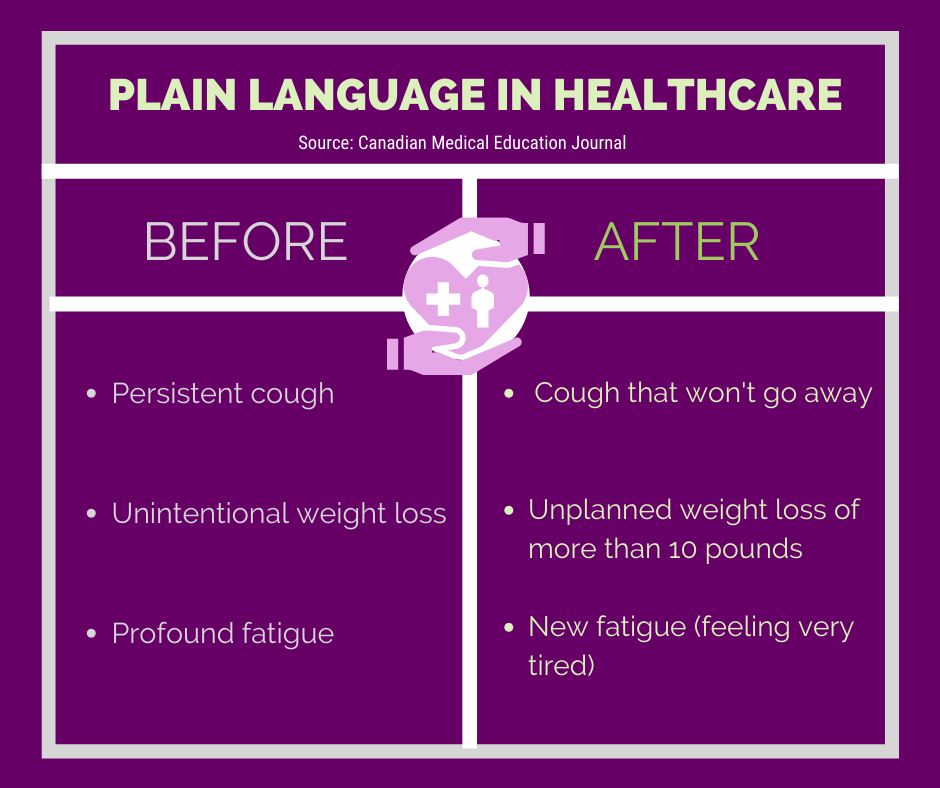Key Takeaways:
- 54% of adults read below a 6th-grade level
- Plain Language is a clear, concise way of writing that promotes better understanding
- Plain Language is essential in the healthcare and legal sectors
- Plain Language benefits everyone, including the highly-educated reader
Did you know translation sometimes involves rendering text from English to English? How you ask? Simple. Actually, Plain and simple. Our translations team offers something called Plain Language translation. It is a valuable service. The importance of Plain Language in business cannot be overstated because it promotes clarity and better understanding.
What is Plain Language?
What is Plain Language, you ask? Plain Language is a style of writing where word choice and structure make the message easier to understand.
The U.S. Federal Government describes it as, “communication your audience can understand the first time they read or hear it.” In the Plain Writing Act of 2010 Plain Language is defined as “clear, concise, [and] well-organized,” following best practices that suit the subject or audience.”
Federal agencies are required to use plain language and train employees on how to do so when communicating with the public. The reason for that? Plain Language is written at a 5th grade level because 54% of U.S. adults ages 16-74 (or roughly 130 million people) read below a sixth-grade level.
That fact came from the U.S. Department of Education (via a 2020 study from Gallup that was funded by the Barbara Bush Foundation for Family Literacy). The impact of low literacy levels is enormous. It could be costing the U.S. as much as $2.2 trillion per year, according to that same Gallup study.
Yet reading level and education level also do not matter in some respect. Everyone benefits from Plain Language. A study by world-leading user experience research company Nielsen Norman Group shows even highly-educated subject matter experts respond well to Plain Language.
With that in mind, it is easy to see the importance of Plain Language in business. With Plain Language, readers are equipped to find whatever information they need, understand it quickly and correctly, and act on it.
Plain Language writing should be:
- Concise
- Simple
- Clear
Stop confusing your audience/customers. Get copy that is plain and simple!
[iti-button url = “https://www.ititranslates.com/blog-quote-request-form/” text = “Request a Quote”]
Benefits of Plain Language in Business
The biggest benefit of Plan Language in business is it helps your company communicate complex ideas in simple ways.
Most of your customers do not have the same in-depth knowledge as your employees. Still, they need to understand what you tell them. Plain Language makes important documents shorter and easier to use.
The following industries understand the importance of Plain Language in business:
Healthcare
Healthcare is the most obvious sector when it comes to the benefits of Plain Language in business. It is extremely costly when people cannot understand instructions from their healthcare provider.
Get this: It is estimated between $106-$238 billion worth of healthcare costs are linked to low adult literacy skills, according to a study by George Washington University’s Milken Institute School of Public Health.
One reason? People with low literacy skills often read and understand one word at a time, which means they often forget the beginning of the sentence before they finish reading. This phenomenon was first pointed out in 1996 by The American Journal of Nursing in “Teaching Patients with Low Literacy Skills.”
Plain Language is especially important in healthcare because the U.S. has roughly 20 percent of the world’s migrants (more than 40 million people), according to Pew Research Center data.
The Pew Center data shows that, of those 40 million people, 23 million people over the age of 5 (47%) have Limited English Proficiency (LEP). This is obviously an issue when it comes to patient experience and patient outcomes.
Plain Language writing in healthcare makes it less likely patients will accidentally misuse their medication. It is also helpful in discharge instructions.
A few examples of Plain Language in healthcare:

Why make something more complicated than it has to be? Sportswriters know the old saying “Write it like you are telling your buddy at the bar what happened (in the game).”
That is especially true for healthcare information: Write it like you are telling your friend what the problem is/was.
While healthcare is unquestionably the top industry for Plain Language, it is hardly the only sector that realizes the importance of Plain Language in business. Here are a few more:
Manufacturing
Manufacturing language is very technical, which makes it confusing and full of words people rarely use in daily conversations.
Plain Language instructions and manuals help workers get up to speed, whether they are building a washing machine or an engine for a Boeing 747.
Plain Language can also help avoid accidents related to products or services. Mistakes can happen, even if you sell to relatively sophisticated B2B buyers.
Legal
Most legal documents make even bookworms’ heads spin. Plain Language legal documents create trust between you and your clients. That can be a long-lasting asset for your law firm’s brand.
Get this: The Harvard Business Review reported in “The Case for Plain-Language Contracts” that when GE Aviation’s digital services business began using plain language contracts in 2014, a three-year study showed negotiation was 60% quicker!
Marketing
Plain Language is a great option when marketing to international audiences because often times they will not understand the nuances of English and its idioms. Language is cultural, so avoid sayings, clichés and slang because they require a deeper understanding that is not universal.
How do I translate a document to Plain Language?
iTi has translated countless documents into Plain Language. Our process starts by discussing the needs and goals of the client.
You may have a few pages you need to translate or a 200-page manual. Before we analyze the text, we take time to understand your objectives. This ensures the new text gets your meaning across. Even though the text is shortened, nothing is left out!
Translating a text to Plain Language means rewriting and restructuring it. It may look very different from the original. You will receive a complete “redline” file comparing your original text to the Plain Language text. This file will describe the rationale for each decision our team made.
By reviewing the two files, you can be sure the meaning is clear, which is the ultimate goal of Plain Language translation. Plain and simple!
Need copy that is easy to understand? Get in touch with our team to start your Plain Language project today!
[iti-button url = “https://www.ititranslates.com/blog-quote-request-form/” text = “Request a Quote”]







Comments are closed here.